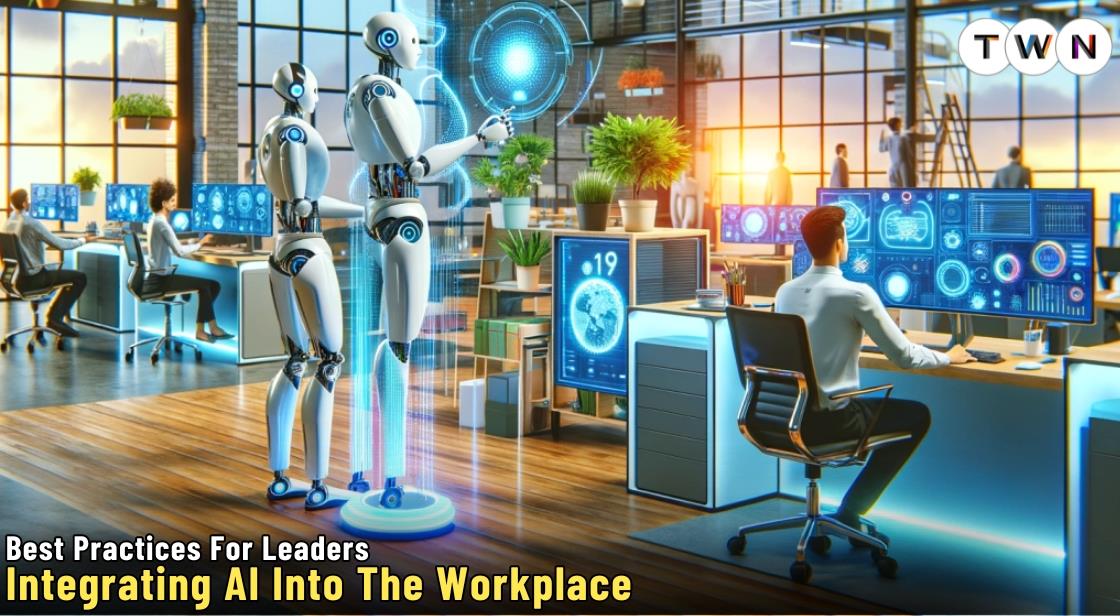Best Practices for Leaders Integrating AI into the Workplace

Blog Post
In the ever-evolving landscape of modern business, Artificial Intelligence (AI) has emerged as a transformative force, reshaping how organizations operate and compete. From automating repetitive tasks to providing deep insights from data, AI offers unprecedented opportunities for enhancing efficiency, fostering innovation, and gaining a competitive edge. However, successfully integrating AI into the workplace involves more than just adopting cutting-edge technology; it requires effective strategies and leadership to navigate the complexities of this advanced technology.
The role of leadership is pivotal in this process. Leaders are responsible for guiding their organizations through the intricacies of AI adoption, setting a clear vision, and ensuring that AI initiatives align with overall business goals. They must address challenges such as workforce upskilling, managing resistance to change, and ensuring ethical implementation. By fostering a culture of continuous learning and innovation, leaders can help their teams embrace AI and unlock its full potential.
This article outlines essential strategies for leaders looking to integrate AI into their organizations effectively. It covers understanding AI's potential, developing a clear AI strategy, investing in the right tools and technology, building a skilled workforce, addressing ethical and privacy concerns, and fostering transparent communication and collaboration. By following these best practices, leaders can ensure a smooth and successful AI integration, ultimately driving their organizations towards greater efficiency and growth in the digital age.
Effective Strategies for Leaders Implementing AI in the Workplace
Overview of AI in the Workplace
Artificial Intelligence (AI) has rapidly become a transformative force in modern workplaces, revolutionizing how businesses operate. From automating routine tasks to providing deep data insights, AI enables organizations to enhance efficiency, drive innovation, and maintain a competitive edge. As AI continues to evolve, its applications in various industries are expanding, making it an indispensable tool for businesses of all sizes.
The Role of Leadership
The successful integration of AI into the workplace hinges significantly on strong leadership. Leaders play a crucial role in guiding their organizations through the complexities of AI adoption. They are responsible for setting the vision, aligning AI initiatives with business goals, and ensuring that the technology is implemented ethically and responsibly. Leaders also need to address the challenges that come with AI integration, such as workforce upskilling and managing potential resistance to change. By fostering a culture of innovation and continuous learning, leaders can help their teams embrace AI and harness its full potential.
1. Understand the Potential of AI
To effectively integrate AI into the workplace, leaders must first grasp the broad capabilities of this technology and how it can transform business operations.
AI Capabilities
In a workplace setting, AI offers a range of powerful capabilities that can drive efficiency and innovation. One of the most prominent uses of AI is automation, where repetitive tasks—such as data entry, customer service responses, and inventory management—can be handled by AI systems, freeing up human employees to focus on more complex, value-added activities. AI is also adept at data analysis, where it can process vast amounts of information at high speed, uncovering patterns, trends, and insights that might be overlooked by human analysts. Furthermore, AI can support decision-making by providing predictive analytics, helping leaders make informed choices based on data-driven forecasts. These capabilities collectively enable businesses to operate more efficiently, respond quickly to changes, and maintain a competitive edge.
Identify Opportunities
Leaders play a key role in identifying where AI can add the most value within their organization. This involves a thorough assessment of current processes and identifying areas that are time-consuming, prone to error, or reliant on large-scale data processing. By engaging with different departments, leaders can pinpoint specific pain points where AI can enhance productivity, improve accuracy, or deliver better customer experiences. Recognizing these opportunities requires a strategic approach, where leaders align AI implementation with the organization’s overall goals and objectives, ensuring that the technology is deployed in areas where it will have the greatest impact.
2. Develop a Clear AI Strategy
For leaders aiming to successfully integrate AI into their organizations, developing a clear AI strategy is essential. This strategy serves as a roadmap, guiding how AI will be used to achieve specific business outcomes and ensuring that the technology is implemented in a way that adds real value.
Set Clear Objectives
The first step in developing an AI strategy is to set clear objectives. Leaders should identify specific goals that they want to achieve through AI integration, such as improving operational efficiency, enhancing customer experience, or driving innovation. By having well-defined objectives, organizations can focus their AI efforts on areas that will have the most significant impact, rather than deploying AI for its own sake.
Align with Business Goals
It's crucial that AI initiatives are aligned with the broader business strategy. Leaders need to ensure that AI projects support the overall vision and goals of the organization. This alignment helps to maximize the return on investment and ensures that AI contributes to the long-term success of the business. For example, if a company’s primary goal is to enhance customer satisfaction, AI applications should be focused on improving customer interactions and personalizing services.
Pilot Projects
Before fully scaling AI initiatives, leaders should consider starting with pilot projects. These smaller, controlled experiments allow organizations to test AI applications in a real-world environment, assess their effectiveness, and identify any challenges or limitations. Pilot projects provide valuable insights and help mitigate risks, ensuring that AI is implemented smoothly and effectively when scaled across the organization.
3. Invest in the Right Tools and Technology
For organizations aiming to integrate AI effectively, selecting the right tools and technologies is crucial. The AI landscape offers a wide array of tools, each designed to cater to specific needs, from automating processes to enhancing decision-making. However, not all AI tools are created equal, and choosing the wrong ones can lead to wasted resources, poor implementation, and missed opportunities.
Choosing the Right AI Tools
When selecting AI tools, leaders must ensure that the chosen technologies align with their organization’s unique needs and objectives. This involves a thorough understanding of the organization's current processes, challenges, and goals. For example, a retail company might prioritize AI tools like Salesforce Einstein for enhancing customer experience through personalized recommendations and predictive analytics. Conversely, a manufacturing firm might focus on AI-driven predictive maintenance solutions such as Uptake or SparkCognition, which help predict equipment failures and optimize maintenance schedules. Conducting a needs assessment and consulting with AI experts can help in identifying tools that will provide the most value for the specific industry and business context.
Scalability and Flexibility
In addition to functionality, scalability and flexibility are key considerations when investing in AI technology. Organizations need solutions that can adapt and grow with their business. For instance, tools like Google Cloud AI and Microsoft Azure AI offer scalable and flexible AI solutions that can handle increased data loads, integrate with new systems, and support additional users. These platforms provide a range of services from machine learning and data analytics to natural language processing, making them suitable for a variety of applications. Flexible AI solutions allow for customization and easy updates, ensuring that the organization can quickly adapt to changing needs and technological advancements. By investing in scalable and flexible AI tools, leaders can future-proof their organization, ensuring that their AI initiatives remain effective and relevant in the long term.
4. Build a Skilled Workforce
Upskill and Reskill Employees
As AI becomes more integrated into the workplace, the skills required to work effectively are evolving. Leaders must prioritize upskilling and reskilling their employees to ensure they can adapt to these changes. Investing in training programs that focus on AI tools and technologies is essential for empowering employees to use these tools confidently and effectively. This could include technical training on specific AI applications, as well as broader education on data literacy, critical thinking, and problem-solving skills. By equipping employees with the necessary skills, organizations can maximize the benefits of AI, improve productivity, and foster innovation.
Foster a Culture of Learning
Creating a culture that encourages continuous learning is vital for the long-term success of AI integration. In an AI-driven workplace, the pace of change is rapid, and the ability to adapt is crucial. Leaders should promote a mindset of lifelong learning, where employees are motivated to stay curious and embrace new technologies. This can be achieved by providing ongoing learning opportunities, such as workshops, seminars, and access to online courses. Additionally, leaders should recognize and reward employees who take initiative in learning and applying new skills. Encouraging collaboration and knowledge sharing among team members can also help reinforce this culture of learning.
By building a skilled workforce and fostering a culture of learning, leaders can ensure that their teams are well-prepared to leverage AI effectively. This not only enhances individual performance but also drives the overall success of the organization in an increasingly AI-driven world.
5. Address Ethical and Privacy Concerns
Ethical AI Usage
Implementing AI ethically is critical to ensure that the technology benefits all stakeholders without causing harm. One of the key considerations in ethical AI usage is addressing bias and fairness. AI systems are often trained on large datasets, which can sometimes contain biases reflecting historical inequities. If not carefully managed, these biases can be perpetuated or even amplified by AI, leading to unfair outcomes in areas like hiring, lending, or law enforcement. Leaders must prioritize the development and deployment of AI systems that are transparent, accountable, and designed to mitigate bias. This involves regularly auditing AI models, involving diverse teams in their creation, and establishing clear guidelines to ensure fairness and equality in AI-driven decisions.
Data Privacy and Security
As organizations increasingly rely on AI to process and analyze vast amounts of data, ensuring robust data privacy and security becomes paramount. AI systems often handle sensitive information, making them potential targets for cyberattacks. Leaders must implement stringent data protection measures to safeguard this information. This includes adhering to data privacy regulations, encrypting data, and regularly updating security protocols to counter emerging threats. Additionally, transparency with stakeholders about how data is collected, used, and protected is essential to maintain trust. By prioritizing data privacy and security, organizations can mitigate risks associated with AI and create a safer, more reliable environment for its use.
Also Read: How Artificial Intelligence is Enhancing the 2024 Olympic Games
6. Communicate and Collaborate
Transparent Communication
Effective communication is essential when integrating AI into the workplace. Leaders must prioritize transparency to ensure that employees are well-informed about the AI initiatives being introduced. Clear communication involves not only explaining the purpose and benefits of AI but also addressing any concerns or misconceptions. Employees need to understand how AI will impact their roles, workflow, and the overall organizational goals. By fostering an open dialogue, leaders can build trust, mitigate resistance, and help employees see AI as a tool that enhances their work rather than a threat. Regular updates, training sessions, and feedback mechanisms are crucial for maintaining clarity and engagement throughout the integration process.
Collaboration Across Departments
Successful AI integration often requires a collaborative approach that spans multiple departments. Different teams bring unique perspectives and expertise to the table, making cross-departmental collaboration vital for leveraging AI effectively. For example, IT professionals, data scientists, and department heads must work together to align AI technologies with business needs, address technical challenges, and ensure seamless implementation. This collaborative effort helps in creating AI solutions that are well-suited to the organization's specific requirements and promotes a unified strategy across the company. Additionally, fostering a culture of teamwork can lead to innovative uses of AI and more efficient problem-solving. By encouraging departments to share insights and work together, leaders can drive more successful AI adoption and maximize its benefits for the organization.
7. Monitor and Evaluate AI Performance
Continuous Monitoring
The effective integration of AI into the workplace requires vigilant and ongoing monitoring of AI systems. Continuous monitoring is essential to ensure that AI applications are delivering the expected results and meeting performance benchmarks. AI systems can sometimes exhibit unpredictable behavior or encounter issues that weren’t anticipated during their development. By implementing regular checks and performance assessments, organizations can identify and address these issues promptly. This proactive approach helps maintain the reliability and accuracy of AI tools, ensuring they contribute positively to business operations and decision-making processes. Monitoring also involves keeping an eye on system efficiency, data integrity, and alignment with business objectives.
Feedback Loops
Establishing robust feedback loops is crucial for the ongoing improvement of AI applications. Feedback loops involve collecting and analyzing input from users and stakeholders regarding the AI system's performance. This feedback can reveal valuable insights into how the AI is functioning in real-world scenarios and highlight areas for refinement. By systematically incorporating user feedback, organizations can make iterative improvements to their AI systems, enhancing their functionality and effectiveness over time. Feedback loops also facilitate the adaptation of AI systems to changing business needs and user expectations, ensuring that the technology remains relevant and beneficial. This iterative process of evaluation and enhancement is key to optimizing AI performance and achieving long-term success with AI integration.
Conclusion
Integrating AI into the workplace presents significant opportunities for enhancing business operations and driving innovation. However, the successful implementation of AI relies on a comprehensive approach that includes understanding the technology’s capabilities, developing a clear strategy, and investing in the right tools. Leaders must also focus on building a skilled workforce, addressing ethical and privacy concerns, and promoting transparent communication and collaboration. Continuous monitoring and feedback loops are vital for optimizing AI performance and ensuring it meets organizational goals. By adopting these strategies, leaders can effectively integrate AI into their organizations, creating a dynamic and forward-thinking workplace that leverages the power of AI to achieve long-term success.
This structure provides a comprehensive guide for leaders looking to effectively integrate AI into their workplace, addressing both strategic and practical considerations.
You May Like
EDITOR’S CHOICE












